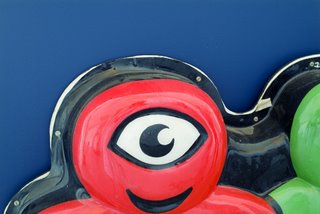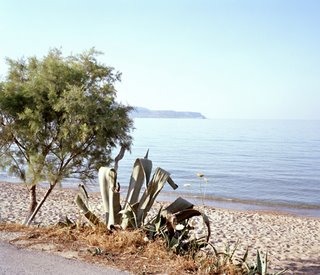Chalk to those that have forgotten their chemistry lessons!
I'm a bit slow getting this post up due to a huge backlog of images I've shot this summer but better late than never.
My chums Fern Alder and Heidi Harvey won silver for their show garden at the RHS Hampton Court Flower Show.
Congratulations girls and to all those that helped make a rather dusty field in Surrey whiter than white. They can now officially say 'as seen on TV' as the BBC did a special feature about how and where they got their inspiration from -the Kent countryside of course.
Lots more info on Fern's website www.spacefx.net and on the BBC site for a 360 view
http://www.bbc.co.uk/gardening/flower_shows/hampton_court_2006/hc06gardens_showkent.shtml
But no one got this shot as it meant waiting until dusk, despite having been there since 6am to get the morning light. Thanks to digital capture I managed to get the projection and chalk backdrop. Something that film could never do and most people at the show never saw because the sun bleached everything.
Thursday, July 27, 2006
CaCo3
Posted by
Emma
at
11:55 pm
0
comments
![]()
Matchstick visitors
 If you are visiting the north west try and go to The Lowry in Manchester's Salford Quays.
If you are visiting the north west try and go to The Lowry in Manchester's Salford Quays.
Some huge and impressive architecture all round this area.
The Lowry is an emporium of art and entertainment. In addition to the permanent display of LS Lowry's work they also have temporary exhibitions. Currently showing is the Folk Archive: Contemporary Popular Art from the UK
http://www.thelowry.com/WhatsOn/EventDetail.aspx?EventId=2359
'Highlight' of the show are the Blackpool Illuminations which were in the process of being installed when I visited. Out of context they are quite bizarre.
I'm currently doing some consultancy work for a new company that will be staging a major exhibition at The Lowry next summer. Details of which will of course be posted here.
Posted by
Emma
at
11:27 pm
0
comments
![]()
Monday, July 17, 2006
Burning and drinking oil

Taking full advantage of the hire car that had no mileage limit and the fact that petrol is cheaper than in the
The Industrial Harbour
The city curls around a Venetian harbour like Rethymnon. As you enter by road you drive down wide boulevards flanked by large villas built in the thirties when the town was booming. Xania seems to be going through a period of regeneration as several of these large houses have been refurbished but there are many left untouched and it creates such an eerie scene especially when you arrive on a Sunday and no one is around. Motorists be warned this town operates a pay and display system. This is the first I have seen in
Souda Bay, Xania
Xania harbour is the classic crescent shape lined with tavernas and cafes with resident customer hawkers boasting about how fresh their food is and made by their mother.
The best time to visit this area is at night. This is when the Mosque of Kioutsouk Hasan (ironically now the Greek tourist police HQ) is lit up and the dome is accentuated by the spotlights. The scene at night reminded me of Kyrínia (Greek) or Girne(Turkish) city on the northern side of
I picked up a free magazine called Frappe named after the iced coffee. Written in German and English there are some good articles and images. It was interesting to read about Cretan olive oil production. The Mihelakis who produce over half a million litres per year, consume as a family 200 litres! The average Cretan consumes 30 litres per year which is excessive but many Greeks live everyday as if it were their last. Considering the way they drive for many it is. In 2000 there were 20.1% of road fatalities per 100,000 of the population of
Frappe magazine ISSN 1109-8090
More images as part of my Greek Identity project are on my website http://emmapeios.spotfolio.com/greece.html
Posted by
Emma
at
3:12 pm
0
comments
![]()
Sabotage and Cheese Salads
 It was too windy to swim today so I decided to visit the
It was too windy to swim today so I decided to visit the
The exhibition finishes on
The mini shop in the museum has some elegant books and printed material for sale. I bought a collection of postcards entitled
The period from the end of the 19th century and the beginning of the 20th was a time when the island passed from Turkish domination to self-government and subsequently to its long hoped union with
These two postcards are from the Everyday Life series (kathimerini zoe).
The first is a group of Turkish whirling dervishes and the second is another posed image, of a woman reclining after smoking from a hookah. One hundred years later and us girls still like the hubbly bubbly!
Historical
Venizelou 27
Heraklion
Across the road from the museum is a restaurant called Elies, Greek for olives. No matter how ultra modern the interior, Elies along with many other restaurants and bars in
Posted by
Emma
at
3:02 pm
1 comments
![]()



